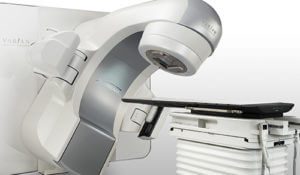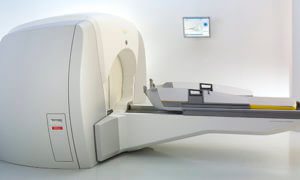Advanced Technologies
Methodist Hospitals is confronting cancer in Northwest Indiana with the latest technology to deliver fast, precise treatments for a wide range of challenging cancer cases. Methodist Hospitals is the only Northwest Indiana cancer program that offers both the Truebeam and Gamma Knife technologies to its patients. With a PhD physicist on staff, Methodist Hospitals offers unsurpassed physics and dosimetry planning.
TrueBeam

Methodist Hospitals’ TrueBeam system is a revolutionary radiotherapy and radiosurgery system that precisely delivers high doses of radiation, narrowly targeting tumors while avoiding surrounding healthy tissues and organs. This multimillion dollar technology opens the door to new treatment possibilities for many complex and challenging cancers, including breast, prostate, lung, along with head and neck.
Learn More about TrueBeam.
Gamma Knife

Home to Northwest Indiana’s first Gamma Knife since 2003, Methodist Hospitals is now equipped with the Gamma Knife Eleka Esprit – the latest generation of the most advanced radiosurgical technology for the non-invasive treatment of malignant brain tumors and benign brain tumors, vascular malformations and trigeminal neuralgia.
Learn More about the Gamma Knife.
The TrueBeam and Gamma Knife technologies enable Methodist Hospitals to offer these radiation oncology treatments:
Stereotactic Body Radiotherapy (SBRT) – Stereotactic Body Radiotherapy is not a surgery, but a completely non-invasive procedure that employs exacting pinpoint radiation directed at the cancer using multiple, precisely contoured beams delivered from many different angles. It is so precise, larger doses of radiation can be delivered over a shorter period of time, sparing normal and healthy tissue.
The potency of doses reduces treatment time to three days as compared to the typical eight-week course of radiation therapy. Stereotactic Body Radiotherapy can be used to support other cancer treatment therapies or in cases where surgery, standard radiation and chemotherapy are either not options or were ineffective. Some patients choose this option to avoid the side effects of chemotherapy or standard radiation.
Benefits of Stereotactic Body Radiotherapy (SBRT):
- 3-day treatment time
- No hospitalization required
- Completely non-invasive
- Alternative to conventional surgery
- Spares healthy tissue
- Appropriate for treating lung cancer, lung metastasis and liver metastasis
Applications of Stereotactic Body Radiotherapy include:
- Medically Inoperable Lung Cancer
- Lung Metastasis
- Liver Metastasis
External Beam Radiation Therapy (EBRT) – One of the most significant breakthroughs in radiation treatments of the last three decades, EBRT can reach hard-to-access tumors with laser accuracy. In EBRT, advanced computer programming allows clinicians to shape the beam around the tumor, avoiding surrounding tissue. Such increased precision can enable physicians to considerably increase the dose directed to a malignant tumor, thus increasing the opportunity of complete tumor elimination.
Brachytherapy – HDR cancer therapy attacks malignant tumors by placing a radioactive source within or around cancerous tissue. Our expert radiation oncologists ensure the maximum radiation dose is given where it is most needed, preventing most of the radiation from reaching the surrounding healthy tissue. Most often administered on an outpatient basis, HDR can decrease the number of actual treatments needed.
Accelerated Partial Breast Irradiation – APBI – is a targeted technique that delivers radiation to the lumpectomy cavity and a small area of surrounding tissue. APBI allows a higher dose of radiation to be delivered thereby decreasing the overall treatments to approximately 5 days.
External Beam Radiation Therapy – EBRT – is a method for delivering high doses of radiation to destroy cancer cells and shrink tumors. Methodist uses the TrueBeam linear accelerator to deliver EBRT.
Meet Our Team of Radiation Oncologists
These accomplished cancer care professionals combine advanced technologies with close, personal attention to deliver the best possible outcomes.
